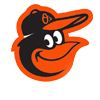SARASOTA, Fla. – Baseball is a game of punches and counterpunches.
Last season, Colton Cowser came out of the gates swinging. The former fifth-overall pick mashed his way through April and March to the tune of a .303/.372/.632/1.004 slash line.
The elite defense didn’t hurt either.
Cowser ranked in the 96th percentile in both outs above average and arm strength. His 11 OAA ranked eighth among all outfielders in the game and was best among left fielders. Couple great defense and an incredible start at the plate, and you’ve got an everyday starter.
But then came a counterpunch.
In May and June, Cowser hit just .185 with a .630 OPS. Such is life for a rookie in Major League Baseball. Cowser landed the first blow early on in the season, but with more information on his strengths and tendencies, pitchers adapted and changed.
In July, things swung back Cowser’s way, as the eventual Rookie of the Year runner-up hit .329 in the month. Just so we’re keeping track, that’s punch, counterpunch, punch.
All in all, the outfielder hit .243 with a .768 OPS on the season and finished fourth on the team in WAR, according to Baseball Reference. Another outstanding rookie year from a young Oriole. But it didn’t wrap up the way anyone wanted it to.
“Not ending the season on a positive note, it left a little sour taste in my mouth,” Cowser said.
A full season in the big leagues afforded Cowser the opportunity to evaluate a full season’s worth of information. For the first time in his career, he could spend an offseason focused on how big league pitchers attacked him throughout the course of a complete year. That’s valuable knowledge at a young player’s disposal.
“I had a meeting with the hitting staff early on, a little Zoom, and we mainly talked about continuing to do things that I do well and also working on certain things and certain situations that I could be better at,” Cowser noted.
What were the areas of focus?
“Working on things moving away from me, things moving into me,” Cowser shared. “More so just approach based. I think last year, I kind of worked myself into some situations where I was a little fastball heavy and I think it’s more so approach than swing.”
We’re gonna break all of that down.
Cowser notes that he may have been “fastball heavy” last season, and the numbers would support that. Around baseball, you’ll find that most hitters tend to hit fastballs better than breaking pitches (slider, curve, knuckle, sweeper, slurve) and off-speed pitches (split, change, fork, screwball). For Cowser, the difference was obvious.
Against fastballs, according to Statcast, the lefty hit .265 with a whiff rate just over 20 percent. Against breaking pitches, the batting average stayed steady, but the whiff rate jumped to over 40 percent. And against off-speed pitches, which Cowser saw nearly 500 times, the rookie hit just .171 with a 42.9 percent whiff rate. With that information in mind, it’s no wonder that the changeup, an off-speed pitch, was the non-fastball offering that Cowser saw most frequently.
Now let’s take a deeper dive into Cowser’s “approach based” focus this offseason.
In fact, let’s start with the first pitch. Cowser excelled at hitting fastballs, a pitch that is often thrown as the first offering in an at-bat. The outfielder swung at the first pitch in nearly 150 plate appearances last season. In those plate appearances, he hit .311 with a .926 OPS and slugged seven of his 24 home runs. A first-pitch ambush seems to have been an effective strategy.
I’m not breaking any news here, but if you’re not going after the first pitch, it’s important to get ahead. Cowser’s on-base percentage took a 250 point leap when he was ahead in the count. “Get into hitter’s counts” is expert analysis, I know.
We’ve covered pitch type and pitch count, so how about pitch location? Cowser noted that he focused on pitches moving both away from and towards him.
To break down his success in different parts of the plate, we’ll look at batter run value, defined by Statcast as “the run impact of an event based on the runners on base, outs, ball and strike count.” Basically, what was your value against a pitch in that spot.
Cowser was money in the middle third of the plate. In the upper-middle, middle-middle, and lower-middle portions of the strike zone, the outfielder had a run value of 5.4. On the inner third of the plate, that number dropped to -3.4. And on the outer third, a sharp drop to -21.7. More plate coverage could lead to a big jump in numbers.
Of course, every hitter across baseball is going to have weaknesses. Aaron Judge’s outer third had a run value of -8.8 in 2024, and he still put together one of the best offensive seasons the game has seen.
But Cowser is working to refine his game. To focus on his strengths, hone in on areas for improvement, and take the next step after a great rookie season.
“I’m wanting to go out there and prove it,” Cowser said. “To myself, to teammates and fans that I can really work on things and have some success.”
By accepting you will be accessing a service provided by a third-party external to https://www.masnsports.com/





